WORLD CLASS COACHING
Developing Soccer Intelligence Through 4v4
By Philip Cauchi

Table of Contents
PART THREE
Game-Like Training
Game-Like Training
The training situations described in this chapter are in progressive order. This means that they progress upon each other where the learning bar is always increased.
1v1 on four goals.

Aim: Run with the ball at speed to score.
Set-up: Area measuring 15 yards in length by 12 yards in width. Two mini goals are positioned at each end line. Players are divided into two equal groups as attackers and defenders. The defenders start eight meters diagonally from the attackers. The attackers start with a ball.
Description: At the coach’s signal which can be either acoustic or visual, the attacker runs with the ball forward while the defender moves quickly to prevent him from scoring. If the defender wins the ball, he aims to counter on the opposite two mini goals. Both players rotate roles after each repetition.
1v1 on four goals scoring from inside the scoring zone.
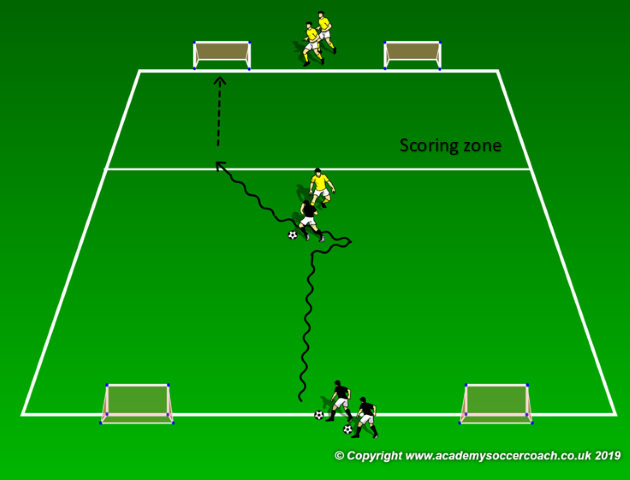
Aim: Disguise opponent using feints to create space to score.
Set-up: Area measuring 15 yards in length by 12 yards in width. A scoring zone measuring 4 yards by 12 yards is marked within this area. Two mini goals are positioned at each end line. Players are divided into two equal groups as attackers and defenders. The attackers and defenders start facing each other fifteen yards apart. The attackers start with a ball.
Description: At the coach’s signal which can be either acoustic or visual, the attacker dribbles the ball forward while the defender moves quickly to prevent him from scoring. The attacker may only score from inside the scoring zone. If the defender wins the ball, he aims to counter on the opposite two mini goals. Both players rotate roles after each repetition.
Progressions:
1. The defender starts defending from the middle of the area instead of from the end line.
2. Reduce the length of the scoring zone to 3 yards.
3. If the defender scores within a particular time frame, the goal is worth double points.
1v1 on two goals from the side.
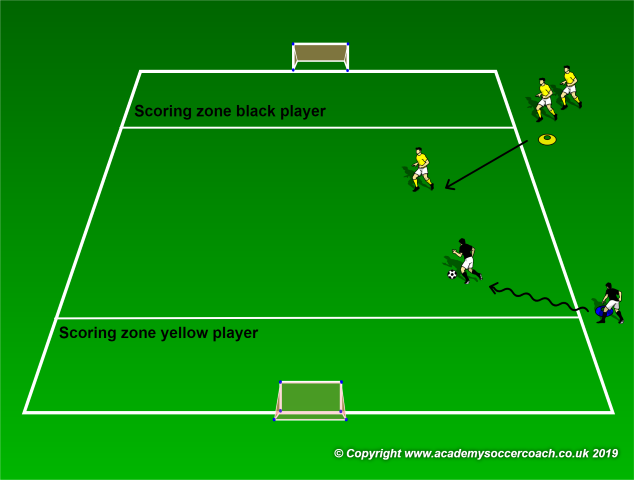
Aim: Dribble past the direct opponent to score.
Set-up: Area measuring 15 yards in length by 12 yards in width. Two scoring zones measuring 2 yards by 12 yards are marked at each end. A mini goal is positioned at each end line. Players are divided into two equal groups as attackers and defenders. The attackers and defenders start eight yards away on the same vertical line. The attackers start with a ball.
Description: At the coach’s signal which can either be acoustic or visual, the attacker dribbles the ball forward with the aim of reaching the scoring zone. The attacker may only score from inside the scoring zone. If the defender wins the ball, he aims to counter on the opposite mini goal and must also score from inside the scoring zone.
Progressions:
1. Both players are numbered and with a ball. When the coach calls out a number, the player representing that number attacks while the other leaves the ball and defends.
2. Same as in 1 but the coach provides a visual signal.
2v1 inside two vertical zones.
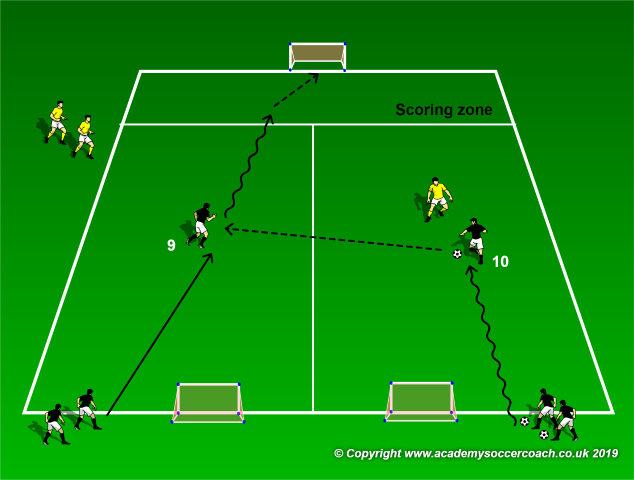
Aim: Stretch the defender to create scoring chances.
Set-up: Area measuring 15 yards in length by 12 yards in width. A scoring zone measuring 2 yards by 12 yards is marked at attackers’ scoring end. A mini goal is positioned at this end while two mini goals are positioned at the opposite end line. Players are divided into two groups of attackers and a group of defenders.
Description: Attacker 10 starts the action by dribbling the ball forward. Attackers must remain inside their assigned vertical zone. The defender is not allowed to enter the scoring zone and aims to win the ball before the attackers get inside this zone. If successful, the defender counters on any of the two mini goals situated on the opposite end line.
Progressions:
1. Reduce the area of play to 12 yards in length by 10 yards in width.
2. The attackers try to score within a pre-allotted time.
2v1 – introducing movements in attack.
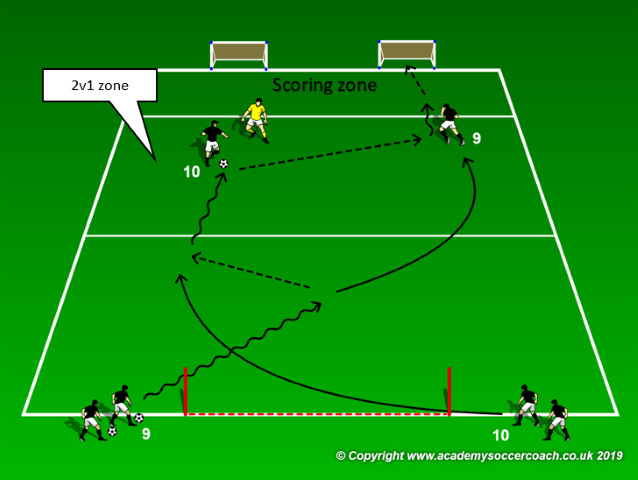
Aim: Pull the defender out of position to create space.
Set-up: Area measuring 17 yards in length by 12 yards in width is divided into two equal horizontal zones. A scoring zone measuring 2 yards by 12 yards is marked at attackers’ scoring end. Two mini goals are positioned at this end while a counter gate (between the red poles) measuring 6 yards in width is added at the opposite end line.
Description: The action starts by having attacker 9 dribbles diagonally while attacker 10 overlaps. Attacker 9 can choose to either pass the ball to attacker 10 or dribbles forward. The defender is only allowed to defend inside the 2v1 zone as shown in the above illustration. Attackers may only score from inside the scoring zone. The defender is not allowed to enter this zone. If the defender wins the ball he counters on the counter gate.
Easier variation: Play 2v0 where the players practice off-the-ball movements to receive and play the ball.
Progression: Play 2v1 where the defender is allowed to move anywhere inside the playing zone and the attackers must conclude within ten seconds of the first move.
2v1 in each horizontal zone.
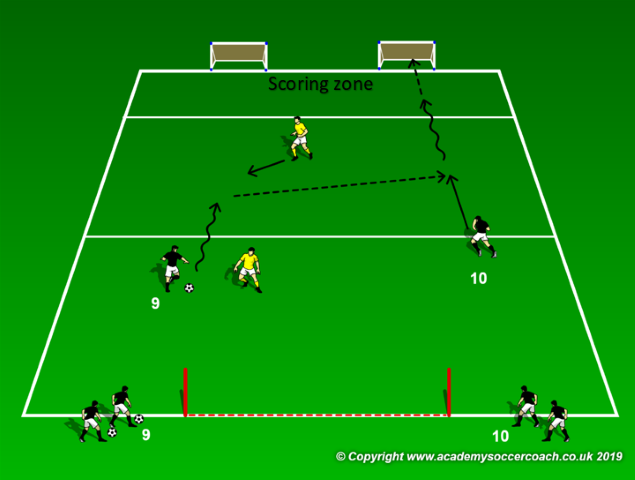
Aim: Off-the-ball movement and support to go past the defenders.
Set-up: Area measuring 17 yards in length by 12 yards in width is divided into two equal horizontal zones. A scoring zone measuring 2 yards by 12 yards marked at attackers’ scoring end. Two mini goals are positioned at this end while a counter gate (between the red poles) measuring 6 yards in width is added at the opposite end line. A defender is positioned in each horizontal zone.
Description: Play is 2v1 in each zone where the attackers aim to dribble past the defender and progress to the next zone. Attackers are only allowed to score from inside the scoring zone. If the defenders win the ball they both leave their assigned zones with the aim of scoring by dribbling through the counter gate.
Progressions:
1. Reduce the area of play to 12 yards in length by 10 yards in width or even to 10 by 8 yards.
2. The defender is allowed to enter the scoring zone to prevent the attackers from scoring.
3. The attackers have a pre-allotted amount of time to score.
3v1 on a narrow and long pitch.
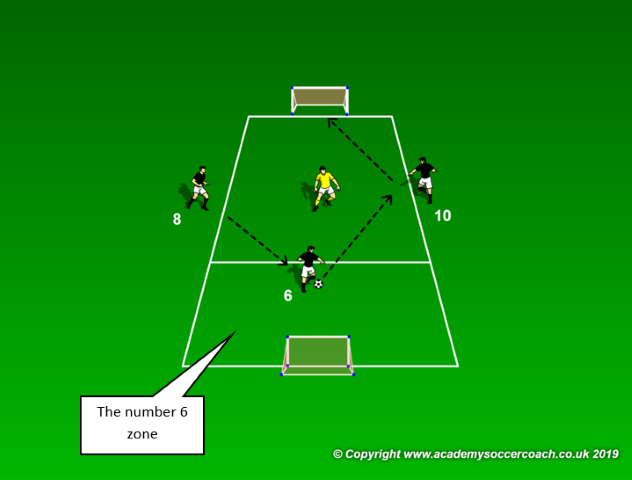
Aim: Form triangles to play around and past the defender.
Set-up: Area measuring 15 yards in length by 10 yards in width. Inside this area another area called “the number 6 zone” is marked. The player designated as the number 6 remains inside this area. The number 8 and number 10 play on their assigned side. A mini goal is placed at each end of the marked area.
Description: Players are restricted to remain on their assigned side or zone and are also allowed to dribble the ball. The defender is not allowed to tackle the ball in the number 6 zone. If the defender wins the ball, he counters on the opposite goal against the number 6.
Progressions:
1. Reduce the area to 12 yards by 8 yards.
2. The defender is allowed to tackle the ball in any zone.
3. Attackers 8 and 10 play inside the area, thus making it more challenging for the attackers to create and exploit space.
4. The attackers have a pre-set amount of time to score.
3v2 on three vertical zones.
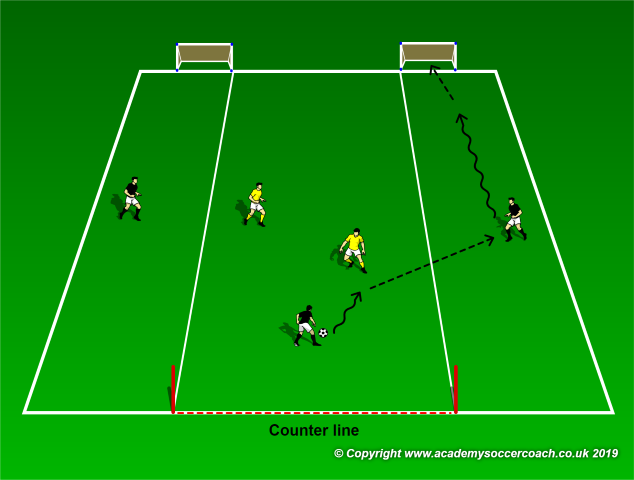
Aim: Stretch the opposition to penetrate and score.
Set-up: Area measuring 20 yards in length by 15 yards in width. Divide the area into three vertical zones where the outside vertical zones measure four yards in width while the central measures seven yards. An attacking team player is positioned inside each vertical zone. The two defenders start from inside the middle zone.
Description: The attackers aim to score in any of the two mini goals. They must however remain inside their assigned area. The two defenders may move anywhere inside the playing area. If the defenders win the ball they counter on the opposite counter line with a dribble.
Progressions:
1. Reduce the playing area to 18 yards in length by 12 yards in width.
2. Introduce a scoring zone for the attackers. Goals may only be scored from inside this zone.
3. Remove the vertical zones and play a normal 3v2 with the players free to move anywhere on the field of play.
3v2 in a vertically divided pitch.
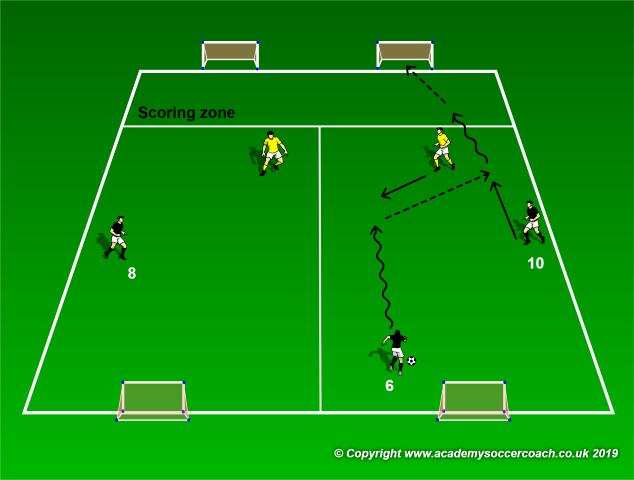
Aim: Stretch the opposition to penetrate and score.
Set-up: Area measuring 20 yards in length by 15 yards in width. Divide the area into two vertical zones and a scoring zone. Three players are designated as attackers while another two as defenders. Two mini goals are positioned on either end of the playing area.
Description: The attackers aim to penetrate and score by dribbling the ball into the scoring zone to score in one of the two mini goals. The defenders are not allowed to track the attackers inside the scoring zone. If the defenders win the ball, they counter on the opposite two mini goals.
Progressions:
1. Reduce the playing area to 18 yards in length by 12 yards in width.
2. The defenders may track the attackers into the scoring zone.
3. The attackers have a pre-allotted amount of time to score.
4. A recovering defender tracks back a number of seconds after the attack starts (3v2+1).
2v1 + 2v1 to finish an attack.
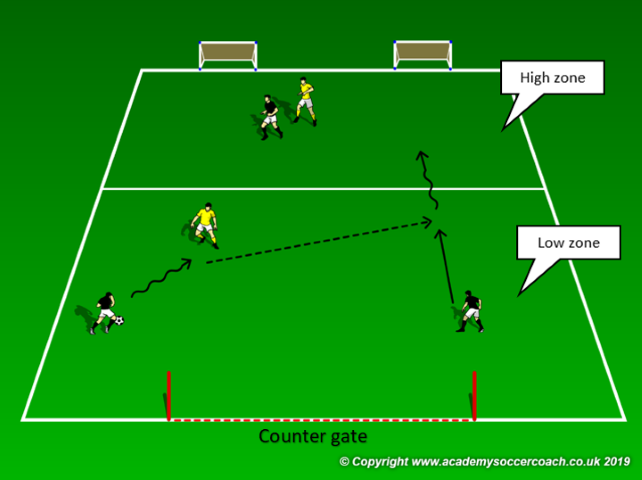
Aim: Play in verticality.
Set-up: Area measuring 20 yards in length by 15 yards in width. Divide the area into two horizontal zones. The low zone measures 12 yards by 15 yards while the high zone measures 8 yards by 15 yards. Two attackers and a defender are positioned in the low zone while another attacker and a defender are positioned in the high zone.
Description: The two attackers in the low zone play against the defender to progress into the high zone. The ball may be passed to the attacker in the high zone or dribbled across the zones. In the high zone another 2v1 situation takes place. If the defenders win the ball they counter on the counter gate positioned at the opposite end of the area.
Progressions:
1. Reduce the playing area to 18 yards in length by 12 yards in width.
2. The attackers have a pre-allotted amount of time to score.
3. The defender inside the low zone is allowed to track back if the attackers progress to the high zone.
3v2 combine with the target player.
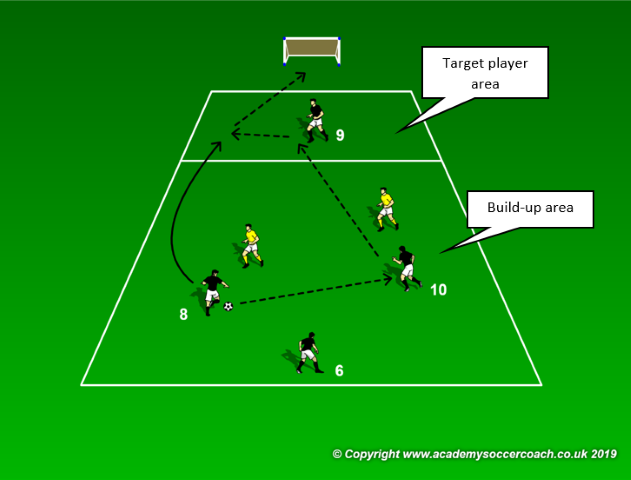
Aim: Play in verticality and support the attack.
Set-up: Area measuring 15 yards in length by 12 yards in width. The final third of the area is the target player area. A striker (9) is positioned inside the target player area. Three attacking players (6, 8 and 10) are positioned inside the build-up area. These three attacking players are opposed by two defenders. A mini goal is placed two yards behind the line.
Description: Attackers (6, 8 and 10) aim to play the ball to the striker and follow the pass to finish at goal. The two defenders aim to prevent this from happening, win the ball and dribble it out of the area. If the ball is lost, the attackers aim to press immediately to regain possession of it before the defenders dribble it out of the area (gegen pressing).
Progressions:
1. A defender may follow the ball inside the target player’s zone to prevent the attackers from scoring.
2. The attackers have a pre-allotted amount of time to score.
4v2 play with wing zones.
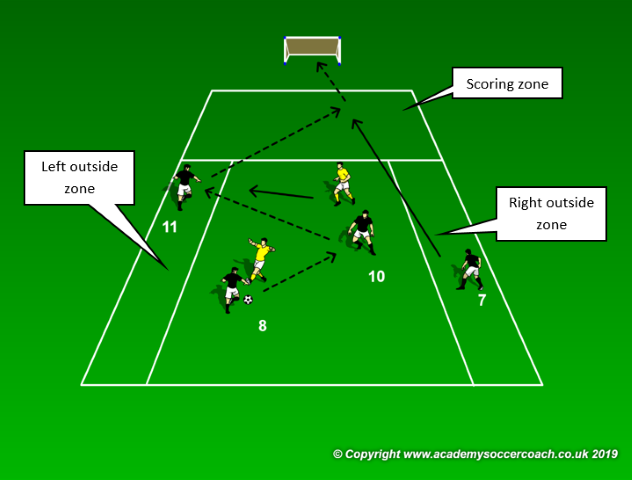
Aim: Play in verticality and support the attack.
Set-up: Area measuring 20 yards in length by 12 yards in width. The area is divided into three vertical areas where the outside zones each measure three meters in width. A scoring zone measuring 5 yards by 15 yards is marked at the end of the grid. Two attackers and two defenders are positioned inside the central zone while an attacking player is positioned in each of the outside zones. A mini goal is placed two yards behind the end line.
Description: Attackers 8 and 10 combine with each other or with the attackers inside the outside zones to play the ball into the scoring zone. Another attacker meets this pass to finish with a shot on the mini goal. The defenders aim to prevent the attackers from scoring, win the ball and dribble it out at the opposite end line, thus playing 2v2 against the 8 and 10.
Progressions:
1. A defender may follow the ball inside the scoring zone.
2. Play against three defenders positioned in the middle horizontal channel.
3v2 + 2v1 goal line soccer.
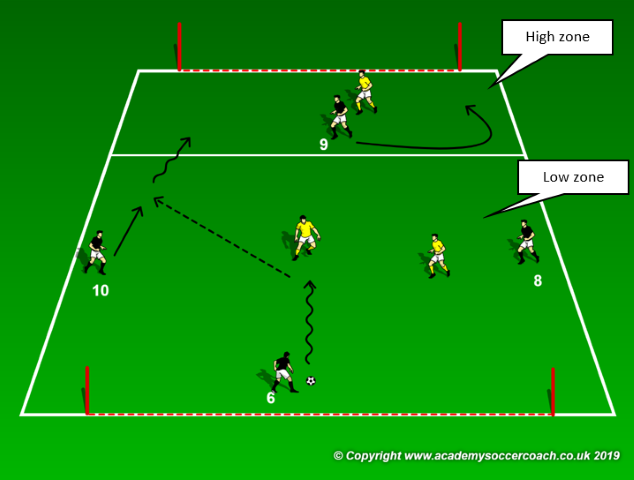
Aim: Play in verticality and support the attack.
Set-up: Area measuring 20 yards in length by 15 yards in width. The area is divided into two horizontal zones. The low zone measures 15 yards by 15 yards while the high zone measures 5 yards by 15 yards. Two gates measuring 10 meters in length are positioned at each end zone. Three attackers and two defenders are positioned inside the low zone, while in the high zone there is an attacker and a defender.
Description: Attackers 6, 8 and 10 aim to play the ball into the upper zone by either dribbling or passing it to the number 9. Once the ball is in the high zone, a 2v1 situation in favour of the attackers is created. The attacking team aims to score by stopping the ball over the defending team’s goal line (between the two poles) to score a point. The defenders aim to win the ball and do the same but on the opposite goal line.
Progression:
Play 4v3 in a single zone by removing the low and high zones.
4v3 building an attack on two goals.
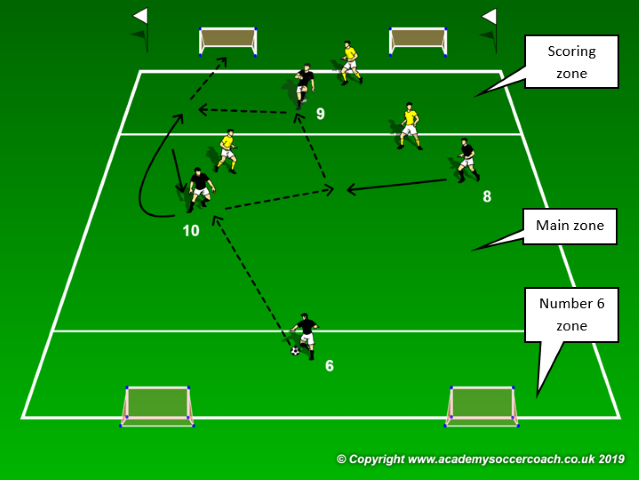
Aim: Play in verticality and support the attack.
Set-up: Area measuring 20 yards by 15 yards. The number 6 zone and the scoring zone both measure 4 yards in length, while the main zone measures 12 yards in length. An attacking player is positioned in the number 6 zone. Two attackers and two defenders are positioned in the main central zone, while another attacker and a defender are situated in the scoring zone.
Description: The attacking team may only score from inside the scoring zone by either combining with the number 9 or by dribbling into this zone. In both circumstances a 2v1 situation is created. A player from the attacking team should always remain inside the number 6 zone. This player cannot be contrasted by the opposing team players. An attacker and a defender are situated in the scoring zone. If the defending team wins possession of the ball, they counter on the opposite mini goals.
4v3 in vertical zones.
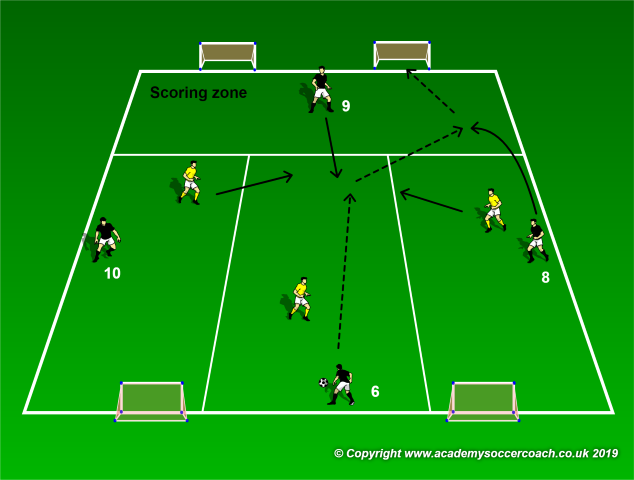
Aim: Play in verticality and support the attack.
Set-up: Area measuring 25 yards in length by 24 yards in width. The area is further divided into three equal vertical zones each measuring 20 yards by 8 yards and a scoring zone measuring 5 yards by 24 yards. A defender and an attacker is positioned in each vertical zone, while another attacker is positioned in the scoring zone. Two goals are positioned at both ends of the area.
Description: The attacking team starts play from attacker 6. All players are to remain inside their assigned area until the ball is played to attacker 9. Attacker 9 may move anywhere to provide support and numerical superiority in any vertical zone. Attackers aim to score inside the two mini goals at the top, while the defenders aim to win the ball and counter on the opposite two mini goals.
Progression:
Play 3v3 plus attacker 9 in the scoring zone. Remove the vertical zones.
2v2+2 attack the goal line.
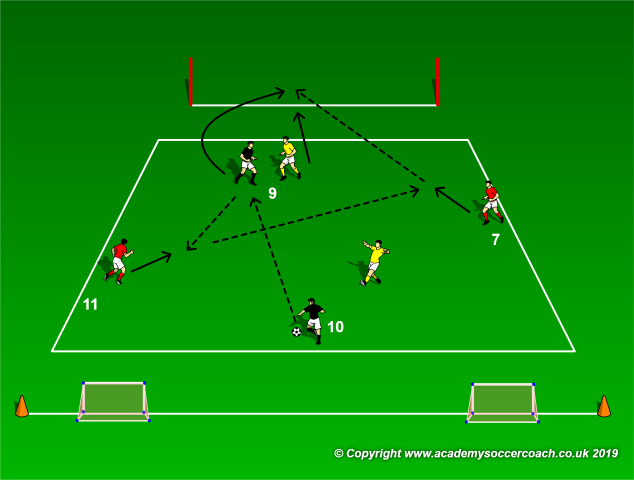
Aim: Play in verticality and support the attack.
Set-up: Area measuring 15 yards by 12 yards. On one side we have a goal line two meters beyond the playing area, while on the opposite side we have another goal line with two mini goals two meters beyond it. Three groups of two players where one group acts as neutral and plays with the team in possession.
Description: The neutral players (reds) are instructed to remain wide. The team in possession play 4v2 against the defending team. However, the neutral players are not allowed to score. This means that the team in possession must work out how and when to play the ball to an attacking player and stop it beyond the goal line. When the defenders win the ball they counter 4v2 in a numerical advantage on the opposite two mini goals.
Progression:
Play 3v3 scoring in the same way with no neutrals.
3v3+1 break the press.
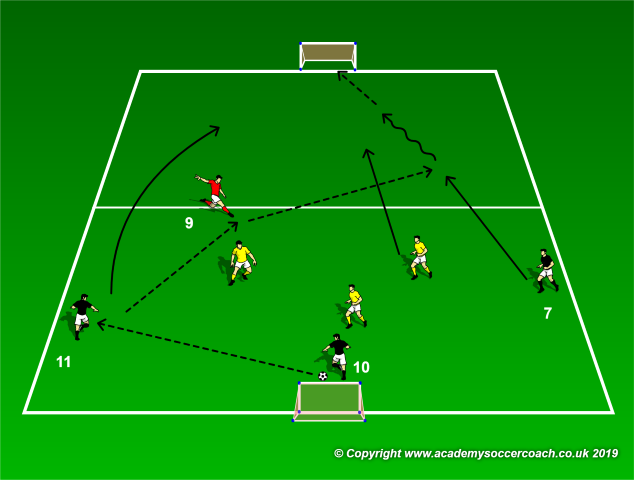
Aim: Play through or behind the defence.
Set-up: Area measuring 25 yards in length by 20 yards in width which is divided into two equal horizontal zones. Three attackers and three defenders plus a neutral player are positioned inside one half of the area. A mini goal is positioned at each end of the area.
Description: Play takes place in one of the two equal horizontal zones where the attacking team aims to play the ball into the opposite zone. The neutral player acts as a number 9 and gives the team height and forward penetrating options. In order for the ball to be played into the opposite zone, it must be passed to another player who should not be waiting inside this area. If this happens, possession of the ball is given to the opposite team. When the ball is played into this area, another attacker and a defender follow, thus making the situation 2v1 for the attackers. When the other team (yellow) has the ball, the same situation occurs but in the opposite direction.


